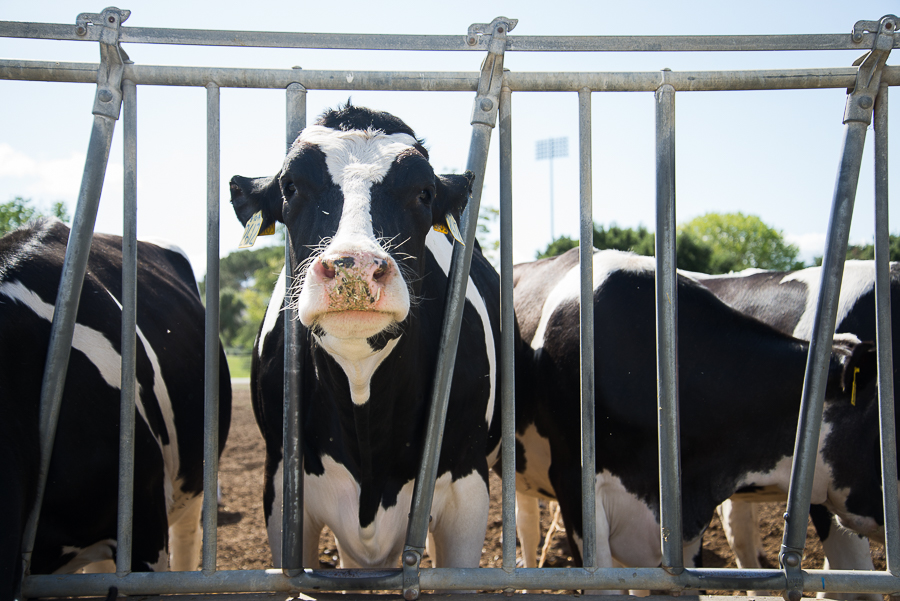
You may have heard them if you lived in the Tercero dorms. You may have even seen them on your morning bike ride to class. More likely than not, you have smelled them on several occasions in your UC Davis undergraduate career. Yes folks, I am referring to the creatures that have given UC Davis its agricultural reputation: the cows.
Davis residents may be aware of their aggie reputation, but few really know about the cows that reside at the UC Davis Dairy Teaching and Research Facility. The dairy, which lies directly behind the Tercero dormitories, is home to around 100 cows that are milked twice a day.
While many imagine a dairy cow to be a standard Black and White Holstein, herd manager Doug Gisi said the dairy facility milks Red Holsteins, Jerseys, Short Horns, Brown Swiss as well as some crossbreeds. The average amount of milk produced by the herd is a whopping 25,000 pounds per cow a year, according to the dairy website. Where does all this milk go? Gisi said the milk is sold to the Hillmar Cheese Company of Hillmar, California.
Managing the feeding, milking and maintenance of 100 cows is no easy feat and requires the helping hands of multiple people every day. To assist the effort, the dairy has had a student residency program for over 20 years.
“We have four resident undergraduate students, that help do the feedings,” Gisi said.
Resident students live in dormitories on the dairy site and are responsible for completing daily chores. In addition to the feedings, students help with calf birthing, maintaining the cow beds and keeping their eyes out for cows that may be in heat.
Vania Leonardes, a sophomore animal science major and resident student, said that cows do not wake up the resident students, although they do have early morning shifts.
“The cows are fed twice a day at 9 am and 3 pm. They aren’t expected to be fed at night, so they don’t cry out,” said Leonardes.
While exploring the dairy with the residents, one can observe an early morning calf feeding. Mini pens that contain sand beds and a covered structure for each calf line one corridor of the dairy.
Another resident student and junior animal science major Sarah Hazeltine said that the dairy has around 10 calves at all times.
“Newborns often weigh around one hundred pounds,” Hazeltine said.
One calf in particular, born on Jan. 9 weighed in at 110 pounds.
Hazeltine said that the safest option for livestock beds is sand. “They all have sand beds because the concrete is too harsh for them and they can get sores on their sides. Sand is inorganic so it doesn’t hold as much bacteria,” said Hazeltine.
Each calf at the dairy is the product of an artificially inseminated mother. Julie Kim, junior environmental science major and resident student, said the dairy has no bulls, which is why artificial insemination is required. Any males found on the dairy that are less than a week old are removed from the facility, said Kim.
Kim, Leonardes and Hazeltine alternate working shifts throughout the week that include jobs such as completing feedings, cleaning and other tasks. While the rest of UC Davis went on a three week winter break, the resident students rotated what days they took off as a condition of their residential responsibilities.
“The cows don’t know when it’s Christmas. Someone has to be here to feed them and take care of them,” Hazeltine said.
Typical hay and grain are not fed to the dairy cattle. Hazeltine said the animals are served a mixture of alfalfa, almond wholes, salt, minerals and a protein pill. Cottonseed is also a common ingredient that serves to help build fat in the cattle.
“We try to use as much bi-product as possible,” Hazeltine said.
The cows of UC Davis serve as a symbol of one of Davis’ greatest prides – its agriculture. Students interested in learning more about the UC Davis Dairy Teaching a Research Facility can enroll in Animal Sciences 1 for the fall, or attend the dairy’s booth at Picnic Day or the Yolo County Fair.
AMANDA HARDWICK can be reached at features@theaggie.org.



